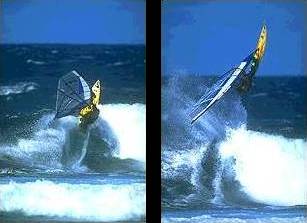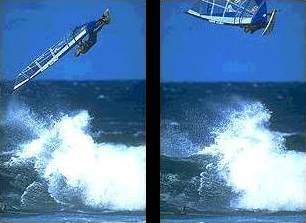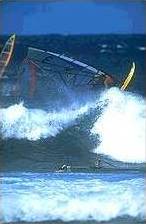This FAQ is
designed to encourage the first time windsufer and answer some
queries he/she may have:
 |
I did enjoy my first
lesson but I found that I didn't get very far. I kept
falling off and didn't really start sailing faster than a
walking pace. What can I do? |
 |
The answer to that
question is not a simple one. A number of factors must be
considered. Firstly, and probably the most likely cause
is that you are just inexperienced and need practice.
Don’t get upset if you fall off a lot and spend more
time in the water than on the board, this is just a
natural progression and we all go through it |
(remember that we all fall off sometimes, even the
professionals). Having said that there a number of things to
consider if you want to minimize your time in the water and go
faster. (A crucial factor is the weather conditions, but
we’ll look at that later on.) First of all look at the way
in which you fall off, most beginners get pulled forwards by a
gust of wind and, either holding tight to the boom, and get flung
forwards on the sail or they let go and having nothing to hold
onto fall back. There are to remedies to this: 1. Consider the
amount of times you fell forwards (towards the sail) and the
amount of times you fell backwards still holding the sail (so the
sail comes down on top of you). The answer for almost all
beginners is that they fell over forwards 99% of the time. So
what dose that mean? Well, it means that a lot or all those times
you fall forward could be avoided. To do this is simple, hold on
to the boom and lean away from it with all your weight. Sure you
could fall backwards once or twice but the main thing is you will
avoid a lot more falling off than if you don’t put all your
weight and strength into it. Always remember that the wind will
support your weight the majority of the time and this is the ONLY
significant way to progress to a faster speed. 2. If you get a
gust of wind that you feel is simply too strong for you to
counter (which you shouldn’t because a good instructor wont
let you out in condition like that) then simply slide your back
hand down the boom towards your front hand. This is called
sheeting out and will let more of the wind pass over the sail
hence reducing the speed and power. This can be done when you
instead of leaning back to compensate but it will limit your
speed. The best way to go fast and stay on is by being aggressive
towards the wind, don’t let is beat you and don’t sheet
out unless you absolutely need to! Be aggressive!

 |
What are the best
weather condition for me to go windsurfing in? |
 |
Weather conditions are a
very important thing to consider before you go
windsurfing. If you have only had one lesson you should
leave it down to your instructor to decide if the weather
conditions are best. However, as not even the best RYA
qualified instructor can control the weather it is often
best to learn somewhere that is |
almost always calm. Good places to learn
windsurfing are at lakes. When I first went windsurfing I hated
it because I was trying to learn on a rough sea where a wave
would knock me off the board every time I stood up. Several years
later I tried it again, this time in a calm, protected bay with
almost no waves and I was hooked. The only downside to learning
on a lake is that often people find that waves become a big
problem when they progress to the sea.

 |
I’m feeling
confident and not falling off but I’m not going as
fast as I want either. What can be done? |
 |
The most likely reason
for this is that you have got a sail which is to small
for the wind speed. Your choice of sail is important for
going as fast as you can and not falling off. Sails range
from about 3m squared up to about 8m squared. Rest
assured you wont be using am 8m for a LONG time. The
large range of size is to make it |
possible for an
expert sailor to go out in almost any weather conditions. An
adult beginner will probably start with a bog standard 4 or 5m
un-battened sail. This kind of sail is fine but lacking in power.
If you are finding it’s not fast enough then ask your
instructor to change it for you. Other remedies of slowness can
be: Slid your back hand down the boom and sheet in and out until
you find an angle that needs the most effort to hold. Now lean
back keeping that angle and if you have a big enough sail you
should go FAST! Another way to speed things up is by slowly
stepping back on the board, this leaves less surface area of the
board in contact with the water. Your instructor will show you
how to do this properly when you are good enough (don’t try
this it if you don't feel confident tacking and sailing
normally).

 |
I’ve had me first
lesson and I like it a lot. When should I be thinking
about buying the equipment I need to go windsurfing? |
 |
You should be thinking
about equipment right form the start. This is because the
kit you choose greatly effects how you will be
windsurfing and ultimately, weather you will enjoy it in
the long run. Ask your instructor to let you use more
than one size and type of sail. If you feel confident ask
to try a smaller board. The idea is to get |
experience with a
range of different setups so you can make an informed choice as
to what you want. You don't have to buy your kit straight after
you have done your RYA level 1, rent some kit or do your level 2
to get more experience. Remember as long as you are renting or
using kit on your course you can easily take it back and change
it for a smaller sail or a bigger board (the most it will cost
you is a walk back up the beach). But if you rush into a purchase
you are not happy with you will be stuck with that kit and it
could cost several hundred quid (and the sport because you will
be put off). Also plan for future use but don't go to far. E.g. A
completely un-battened sail should not even be considered because
it will be slow and boring as soon as you learn to fully power up
without falling off.

This sight is
still under construction and any comments would be welcome.
E-Mail me at:




Copyright
� 1998 BrightBlade












